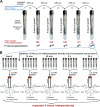Distinctive physiology of polyphosphate-accumulating Beggiatoa suggests an important role in benthic phosphorus cycling
- PMID: 40304518
- PMCID: PMC12094007
- DOI: 10.1128/aem.02330-24
Distinctive physiology of polyphosphate-accumulating Beggiatoa suggests an important role in benthic phosphorus cycling
Abstract
Filamentous sulfide-oxidizing Beggiatoa spp., which occasionally form extensive white microbial mats, are widespread in marine coastal environments and can achieve significant biomass because of their large size. Their ability to store phosphates in the polymerized form of polyphosphates makes them potential key players in altering the phosphorus (P) cycle at the sediment-water interface. This study examined phosphate uptake and polyphosphate formation in a P-starved culture of Beggiatoa sp. 35Flor strain. Remarkably, even after sustained P starvation over five generations, the mat establishment rate of the examined culture was 46%, demonstrating considerable plasticity in response to different levels of phosphate availability. Under these P-depleted conditions, at least 17% of filaments still contained polyphosphates, highlighting their critical role in their metabolism. Upon reintroduction of phosphate to starved cultures, an extremely rapid phosphate uptake was observed within the first 10 min, with rates reaching up to 12.4 mmol phosphate g-1 protein h-1, which is significantly higher than values previously reported in the literature for similar-sized organisms. The high phosphate uptake capacity of Beggiatoa spp., estimated at 0.6-6 mmol m-2 d-1 for typical densities of filaments in coastal sediments, suggests that under certain environmental conditions, these bacteria could act as a P sink and thus play an important role in benthic P cycling.
Importance: Sulfide-oxidizing bacteria of the genus Beggiatoa occur ubiquitously in marine coastal sediments and have a large potential to influence phosphate fluxes at the sediment-water interface, owing to their ability to accumulate polyphosphate and their large size. However, the extent to which these bacteria can contribute to phosphorus (P) sequestration or release remains poorly assessed. The importance of this study lies in demonstrating the remarkable flexibility in the adaptation of the strain Beggiatoa sp. 35Flor to varying P availability, including prolonged P starvation and its capacity to rapidly uptake and store available phosphate in the form of polyphosphate. When considered on a global scale, these physiological traits could form the basis for Beggiatoa's role in moderating P fluxes.
Keywords: coastal ocean; marine sediments; phosphate starvation; phosphate uptake; polyphosphate; sulfur bacteria.
Conflict of interest statement
The authors declare no conflict of interest.
Figures




Similar articles
-
Sulfide induces phosphate release from polyphosphate in cultures of a marine Beggiatoa strain.ISME J. 2011 Mar;5(3):497-506. doi: 10.1038/ismej.2010.135. Epub 2010 Sep 9. ISME J. 2011. PMID: 20827290 Free PMC article.
-
Simultaneous Visualization of Enzymatic Activity in the Cytoplasm and at Polyphosphate Inclusions in Beggiatoa sp. Strain 35Flor Incubated with 18O-Labeled Water.mSphere. 2018 Dec 19;3(6):e00489-18. doi: 10.1128/mSphere.00489-18. mSphere. 2018. PMID: 30567898 Free PMC article.
-
Unusual polyphosphate inclusions observed in a marine Beggiatoa strain.Antonie Van Leeuwenhoek. 2012 Feb;101(2):347-57. doi: 10.1007/s10482-011-9640-8. Epub 2011 Sep 10. Antonie Van Leeuwenhoek. 2012. PMID: 21909788 Free PMC article.
-
Biology of polyphosphate-accumulating bacteria involved in enhanced biological phosphorus removal.FEMS Microbiol Rev. 1994 Oct;15(2-3):137-53. doi: 10.1111/j.1574-6976.1994.tb00131.x. FEMS Microbiol Rev. 1994. PMID: 7946465 Review.
-
Application of polyphosphate metabolism to environmental and biotechnological problems.Biochemistry (Mosc). 2000 Mar;65(3):324-31. Biochemistry (Mosc). 2000. PMID: 10739475 Review.
References
-
- Follmi K. 1996. The phosphorus cycle, phosphogenesis and marine phosphate-rich deposits. Earth Sci Rev 40:55–124. doi:10.1016/0012-8252(95)00049-6 - DOI
-
- Gächter R, Müller B. 2003. Why the phosphorus retention of lakes does not necessarily depend on the oxygen supply to their sediment surface. Limnol Oceanogr 48:929–933. doi:10.4319/lo.2003.48.2.0929 - DOI
-
- Hupfer M, Gloess S, Grossart H. 2007. Polyphosphate-accumulating microorganisms in aquatic sediments. Aquat Microb Ecol 47:299–311. doi:10.3354/ame047299 - DOI
MeSH terms
Substances
Grants and funding
LinkOut - more resources
Full Text Sources
Miscellaneous

